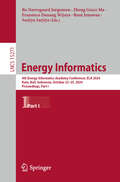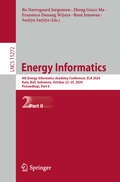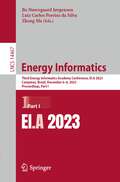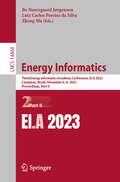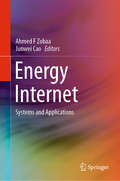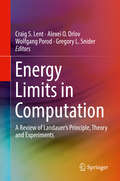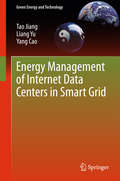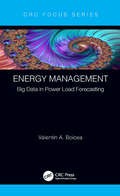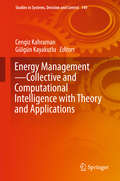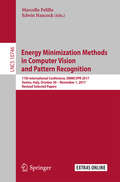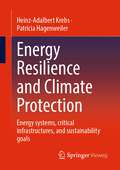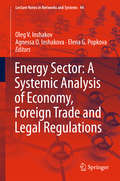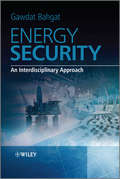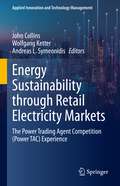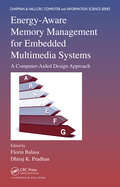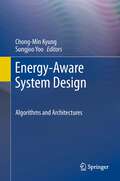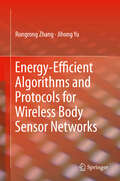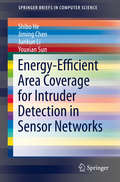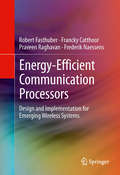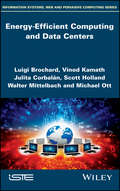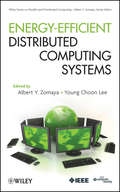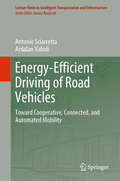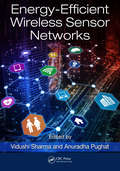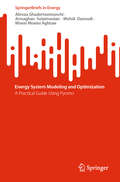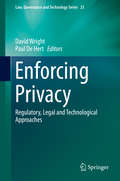- Table View
- List View
Energy Informatics: 4th Energy Informatics Academy Conference, EI.A 2024, Kuta, Bali, Indonesia, October 23–25, 2024, Proceedings, Part I (Lecture Notes in Computer Science #15271)
by Roni Irnawan Bo Nørregaard Jørgensen Zheng Grace Ma Fransisco Danang Wijaya Sarjiya SarjiyaThe two-volume set LNCS 15271 and 15272 constitutes the proceedings of the 4th Energy Informatics Academy Conference, EI.A 2024, held in Kuta, Bali, Indonesia, during October 23–25, 2024. The 40 full papers and 8 short papers included in these proceedings were carefully reviewed and selected from 64 submissions. They are categorized under the topical sections as follows: Part I: IoT Edge Computing, and Software Innovations in Energy, Big Data Analytics and Cybersecurity in Energy, Digital Twin Technology and Energy Simulations, Energy data and consumer behaviors, and Digitalization of District Heating and Cooling Systems. Part II: Smart Buildings and Energy Communities, Energy Pricing, Trading, and Market Dynamics, Demand Flexibility and Energy Conservation Strategies, Optimization of Energy Systems and Renewable Integration and Energy System Resilience and Reliability. Chapter &“Automation Level Taxonomy for Time Series Forecasting Services: Guideline for Real-World Smart Grid Applications&” is available open access under a Creative Commons Attribution 4.0 International License via link.springer.com.
Energy Informatics: 4th Energy Informatics Academy Conference, EI.A 2024, Kuta, Bali, Indonesia, October 23–25, 2024, Proceedings, Part II (Lecture Notes in Computer Science #15272)
by Roni Irnawan Bo Nørregaard Jørgensen Zheng Grace Ma Fransisco Danang Wijaya Sarjiya SarjiyaThe two-volume set LNCS 15271 and 15272 constitutes the proceedings of the 4th Energy Informatics Academy Conference, EI.A 2024, held in Kuta, Bali, Indonesia, during October 23–25, 2024. The 40 full papers and 8 short papers included in these proceedings were carefully reviewed and selected from 64 submissions. They are categorized under the topical sections as follows: Part I: IoT Edge Computing, and Software Innovations in Energy, Big Data Analytics and Cybersecurity in Energy, Digital Twin Technology and Energy Simulations, Energy data and consumer behaviors, and Digitalization of District Heating and Cooling Systems. Part II: Smart Buildings and Energy Communities, Energy Pricing, Trading, and Market Dynamics, Demand Flexibility and Energy Conservation Strategies, Optimization of Energy Systems and Renewable Integration and Energy System Resilience and Reliability.
Energy Informatics: Third Energy Informatics Academy Conference, EI.A 2023, Campinas, Brazil, December 6–8, 2023, Proceedings, Part I (Lecture Notes in Computer Science #14467)
by Bo Nørregaard Jørgensen Luiz Carlos Pereira da Silva Zheng MaThis two-volume set LNCS 14467-14468 constitutes the proceedings of the First Energy Informatics Academy Conference, EI.A 2023,held in Campinas, Brazil, in December 2023. The 39 full papers together with 8 short papers included in these volumes were carefully reviewed and selected from 53 submissions. The conference focuses on the application of digital technology and information management to facilitate the global transition towards sustainable and resilient energy systems.
Energy Informatics: Third Energy Informatics Academy Conference, EI.A 2023, Campinas, Brazil, December 6–8, 2023, Proceedings, Part II (Lecture Notes in Computer Science #14468)
by Bo Nørregaard Jørgensen Luiz Carlos Pereira da Silva Zheng MaThis two-volume set LNCS 14467-14468 constitutes the proceedings of the First Energy Informatics Academy Conference, EI.A 2023,held in Campinas, Brazil, in December 2023. The 39 full papers together with 8 short papers included in these volumes were carefully reviewed and selected from 53 submissions. The conference focuses on the application of digital technology and information management to facilitate the global transition towards sustainable and resilient energy systems.
Energy Internet: Systems and Applications
by Ahmed F Zobaa Junwei CaoThis textbook is the first of its kind to comprehensively describe the energy Internet, a vast network that efficiently supplies electricity to anyone anywhere and is an internet based wide area network for information and energy fusion. The chapters are organized into five parts: Architecture and Design, Energy Switching and Routing, Information and Communication, Energy Management Systems and Energy Market and Trading, and capture the spectrum of this exponential transformation, while also presenting the plethora of open problems that this transformation poses for researchers from mixed academic backgrounds. The scope includes key technologies on distributed energy sources, microgrids, energy storage, solar and wind energy, power grid, smart grid, power quality, power electronics, data centers, distributed computing and networking, cloud computing and big data, and software-defined networking. The book presents the basic principles of energy internet and emphasizes the current research trends in the field of energy Internet at an advanced level. It includes instructor materials, case-studies, and worked examples throughout. This is an ideal resource for students in advanced graduate-level courses and special topics in energy, information and control systems, and is a useful tool for utility engineers who seek an intuitive understanding of the emerging applications of energy Internet.
Energy Limits in Computation: A Review of Landauer’s Principle, Theory and Experiments
by Wolfgang Porod Craig S. Lent Alexei O. Orlov Gregory L. SniderThis book is a single-source reference to the issues involved in the Landauer principle, which has gained new prominence recently, due to the large amount of heat generated by today’s computers. If Landauer’s principle is correct, there may be ways to build computers that dissipate far less power (corresponding to heat generated) than today’s computers. This book brings together all sides of the discussions regarding Landauer’s principle, both theoretical and experimental, empowering readers to gain better understanding of dissipation in computation, and the limits if any to progress in computation related to energy dissipation. It represents the best and most thorough examination of the important issue of Landauer’s principle that is available in one volume.Provides an in-depth investigation of the Landauer principle and how it relates to the possible existence of lower bounds on dissipation in computation;Gathers together both sides of the discussion: those who agree with Landauer and his conclusions, and those who think that Landauer was not correct, offering fresh perspective on the issues in the new light of experiments;Offers insight into the future of silicon CMOS and the limits if any to progress in computation related to energy dissipation.
Energy Management of Internet Data Centers in Smart Grid
by Tao Jiang Liang Yu Yang CaoThis book reports the latest findings on intelligent energy management of Internet data centers in smart-grid environments. The book gathers novel research ideas in Internet data center energy management, especially scenarios with cyber-related vulnerabilities, power outages and carbon emission constraints. The book will be of interest to university researchers, R&D engineers and graduate students in communication and networking areas who wish to learn the core principles, methods, algorithms, and applications of energy management of Internet data centers in smart grids.
Energy Management: Big Data in Power Load Forecasting
by Valentin A. BoiceaThis book introduces the principle of carrying out a medium-term load forecast (MTLF) at power system level, based on the Big Data concept and Convolutionary Neural Network (CNNs). It also presents further research directions in the field of Deep Learning techniques and Big Data, as well as how these two concepts are used in power engineering. Efficient processing and accuracy of Big Data in the load forecast in power engineering leads to a significant improvement in the consumption pattern of the client and, implicitly, a better consumer awareness. At the same time, new energy services and new lines of business can be developed. The book will be of interest to electrical engineers, power engineers, and energy services professionals.
Energy Management—Collective and Computational Intelligence with Theory and Applications: Collective And Computational Intelligence With Theory And Applications (Studies In Systems, Decision And Control #149)
by Cengiz Kahraman Gülgün KayakutluThis book presents a selection of recently developed collective and computational intelligence techniques, which it subsequently applies to energy management problems ranging from performance analysis to economic analysis, and from strategic analysis to operational analysis, with didactic numerical examples. As a form of intelligence emerging from the collaboration and competition of individuals, collective and computational intelligence addresses new methodological, theoretical, and practical aspects of complex energy management problems. The book offers an excellent reference guide for practitioners, researchers, lecturers and postgraduate students pursuing research on intelligence in energy management. The contributing authors are recognized researchers in the energy research field.
Energy Minimization Methods in Computer Vision and Pattern Recognition: Second International Workshop, Emmcvpr'99, York, Uk, July 26-29, 1999, Proceedings (Lecture Notes in Computer Science #1654)
by Marcello Pelillo Edwin HancockThis volume constitutes the refereed proceedings of the 11th International Conference on Energy Minimization Methods in Computer Vision and Pattern Recognition, EMMCVPR 2017, held in Venice, Italy, in October/November 2017. The 37 revised full papers were carefully reviewed and selected from 51 submissions. The papers are organized in topical sections on Clustering and Quantum Methods; Motion and Tracking; Image Processing and Segmentation; Color, Shading and Reflectance of Light; Propagation and Time-evolution; and Inference, Labeling, and Relaxation.
Energy Resilience and Climate Protection: Energy systems, critical infrastructures, and sustainability goals
by Heinz-Adalbert Krebs Patricia HagenweilerThe increasingly interconnected, fast-moving, unmanageable and unpredictable world brings with it an unprecedented variety of known and as yet unknown challenges and risks. Some of the global risks have a direct impact on critical infrastructures as well as those of energy supply in particular. A high level of functionality of critical infrastructures (CRITIS), which include the sectors of energy, information technology and telecommunications, transportation and traffic, health, water, food, finance and insurance, government and administration, as well as media and culture, is indispensable for a modern industrial society. In the context of the Corona crisis of 2020/2021, the worldwide inadequate preparation for pandemics became obvious, although the probability of epidemic outbreaks and their global spread has increased significantly in recent decades and was thus predictable to a certain extent. Moreover, it has been shown that in a globally interconnected world, complex crisis phenomena can mutually amplify and thus escalate within a short period of time. In particular, the deficits in preparedness for major risks that became apparent in the course of the Corona pandemic cannot be managed by nation states alone, especially since the probability of such events has risen continuously in recent decades and will continue to increase with growing globalization and urbanization and, in particular, as a result of climate change and its consequences. This publication addresses the challenges of energy resilience and climate protection, which will require immense attention in the future.
Energy Sector: A Systemic Analysis of Economy, Foreign Trade and Legal Regulations (Lecture Notes in Networks and Systems #44)
by Elena G. Popkova Oleg V. Inshakov Agnessa O. InshakovaThis book is a comprehensive economic and legal study of the theoretical and practical aspects of the problems of increasing energy efficiency; self-motivation of energy saving by business entities within the framework of their corporate responsibility; regulatory mechanisms to stimulate energy conservation in the economy; civil-law regulation of foreign trade turnover of energy resources between economic entities of the Russian Federation and companies of member states of international integration associations – the CIS, EEMP, the EU and BRICS. It argues that technological energy saving plays a key role in reducing the energy intensity and increasing the energy efficiency of the economy, and substantiates the need for institutional support – including legal support for the participation of the Russian Federation – in various forms of international cooperation. Lastly, based on an analysis of current legislation, programs and recommendations, judicial and contractual practices, customs and trade procedures, it offers proposals for the developing, improving and unifying civil law regulation of obligations in the sphere of international trade in energy resources, as well as methodological recommendations for drafting foreign trade contracts in the energy sector.
Energy Security
by Gawdat BahgatSecurity of Energy supply is a major concern for all modern societies, intensified by skyrocketing demand in India and China and increasing international competition over fossil fuel deposits. Energy Security: An Interdisciplinary Approach gives A comparative analysis from both consumers' and producers' perspectives. It uniquely combines economics, geology, international relations, business, history, public management and political science, in one comprehensive volume, highlighting the vulnerabilities and need to move to more sustainable energy sources.The author provides a number of useful case studies to demonstrate the theory, including perspectives from consuming regions such as the United States, the European Union, and China, and from exporting regions; the Middle East, Africa, Russia and the Caspian Sea.Key features include:coverage on theoretical and empirical frameworks so readers are able to analyse concepts relevant to new laws and policies in energy securityup-to-date coverage on 'green energy', outlining research on the balance between meeting energy needs and avoiding polluting the environmentan examination of the three most prominent international energy organizations; International Energy Agency, International Energy Forum, and Organization of Petroleum Exporting Countries a full Glossary listing all important terms used in the energy fieldThis study holds important information for policymakers, politicians, energy specialists, scientists and post-graduate and final year students of energy and international relations. With its clear written style, it will also engage other professionals who are interested in international political economy and the future of global energy.
Energy Sustainability through Retail Electricity Markets: The Power Trading Agent Competition (Power TAC) Experience (Applied Innovation and Technology Management)
by John Collins Andreas L. Symeonidis Wolfgang KetterThe world is moving away from demand-driven electricity markets supplied by centralized generation and distribution of fossil-fuel-produced electricity. Increasing reliance on weather-dependent renewable sources will require a shift toward a supply-driven paradigm, while beneficial electrification, including widespread adoption of electric vehicles, heat pumps, and batteries will offer considerable but widely distributed demand flexibility that can be used to compensate for supply variability. The open-source Power Trading Agent Competition (Power TAC) platform simulates a decentralized future, modeling the high complexity of future retail electricity markets. This book describes a variety of approaches to profitable trading in realistic wholesale and retail electricity markets. It presents actionable insights from extensive exploration of policies and business models for retail electricity markets gained from a decade of Power TAC tournaments, and from research inspired by the Power TAC experience. Featuring contributions from tournament designers, competitors, and scientists combining best practices from computer science and economics and management science, this book is of benefit to academics, researchers, practitioners and policy makers in sustainable energy and wholesale and retail electricity markets.
Energy-Aware Memory Management for Embedded Multimedia Systems: A Computer-Aided Design Approach (Chapman & Hall/CRC Computer and Information Science Series)
by Dhiraj K. Pradhan Florin BalasaEnergy-Aware Memory Management for Embedded Multimedia Systems: A Computer-Aided Design Approach presents recent computer-aided design (CAD) ideas that address memory management tasks, particularly the optimization of energy consumption in the memory subsystem. It explains how to efficiently implement CAD solutions, including theoretical methods an
Energy-Aware System Design
by Chong-Min Kyung Sungjoo YooPower consumption becomes the most important design goal in a wide range of electronic systems. There are two driving forces towards this trend: continuing device scaling and ever increasing demand of higher computing power. First, device scaling continues to satisfy Moore's law via a conventional way of scaling (More Moore) and a new way of exploiting the vertical integration (More than Moore). Second, mobile and IT convergence requires more computing power on the silicon chip than ever. Cell phones are now evolving towards mobile PC. PCs and data centers are becoming commodities in house and a must in industry. Both supply enabled by device scaling and demand triggered by the convergence trend realize more computation on chip (via multi-core, integration of diverse functionalities on mobile SoCs, etc.) and finally more power consumption incurring power-related issues and constraints. Energy-Aware System Design: Algorithms and Architectures provides state-of-the-art ideas for low power design methods from circuit, architecture to software level and offers design case studies in three fast growing areas of mobile storage, biomedical and security. Important topics and features: - Describes very recent advanced issues and methods for energy-aware design at each design level from circuit and architecture to algorithm level, and also covering important blocks including low power main memory subsystem and on-chip network at architecture level - Explains efficient power conversion and delivery which is becoming important as heterogeneous power sources are adopted for digital and non-digital parts - Investigates 3D die stacking emphasizing temperature awareness for better perspective on energy efficiency - Presents three practical energy-aware design case studies; novel storage device (e.g., solid state disk), biomedical electronics (e.g., cochlear and retina implants), and wireless surveillance camera systems. Researchers and engineers in the field of hardware and software design will find this book an excellent starting point to catch up with the state-of-the-art ideas of low power design.
Energy-Efficient Algorithms and Protocols for Wireless Body Sensor Networks
by Jihong Yu Rongrong ZhangThis book provides a systematic treatment of the theoretical foundation and algorithmic tools necessary in the design of energy-efficient algorithms and protocols in wireless body sensor networks (WBSNs). These problems addressed in the book are of both fundamental and practical importance. Specifically, the book delivers a comprehensive treatment on the following problems ranging from theoretical modeling and analysis, to practical algorithm design and optimization: energy-efficient clustering-based leader election algorithms in WBSNs; MAC protocol for duty-cycling WBSNs with concurrent traffic; multi-channel broadcast algorithms in duty-cycling WBSNs; and energy-efficient sleep scheduling algorithms in WBSNs. Target readers of the book are researchers and advanced-level engineering students interested in acquiring in-depth knowledge on the topic and on WBSNs and their applications, both from theoretical and engineering perspective.
Energy-Efficient Area Coverage for Intruder Detection in Sensor Networks
by Shibo He Jiming Chen Junkun Li Youxian SunThis Springer Brief presents recent research results on area coverage for intruder detection from an energy-efficient perspective. These results cover a variety of topics, including environmental surveillance and security monitoring. The authors also provide the background and range of applications for area coverage and elaborate on system models such as the formal definition of area coverage and sensing models. Several chapters focus on energy-efficient intruder detection and intruder trapping under the well-known binary sensing model, along with intruder trapping under the probabilistic sensing model. The brief illustrates efficient algorithms rotate the duty of each sensor to prolong the network lifetime and ensure intruder trapping performance. The brief concludes with future directions of the field. Designed for researchers and professionals working with wireless sensor networks, the brief also provides a wide range of applications which are also valuable for advanced-level students interested in efficiency and networking.
Energy-Efficient Communication Processors
by Francky Catthoor Praveen Raghavan Frederik Naessens Robert FasthuberThis book describes a new design approach for energy-efficient, Domain-Specific Instruction set Processor (DSIP) architectures for the wireless baseband domain. The innovative techniques presented enable co-design of algorithms, architectures and technology, for efficient implementation of the most advanced technologies. To demonstrate the feasibility of the author's design approach, case studies are included for crucial functionality of advanced wireless systems with increased computational performance, flexibility and reusability. Designers using this approach will benefit from reduced development/product costs and greater scalability to future process technology nodes.
Energy-Efficient Computing and Data Centers: Energy Efficient Computing And Data Centers
by Luigi Brochard Vinod Kamath Julita Corbalán Scott Holland Walter Mittelbach Michael OttData centers consume roughly 1% of the total electricity demand, while ICT as a whole consumes around 10%. Demand is growing exponentially and, left unchecked, will grow to an estimated increase of 20% or more by 2030. This book covers the energy consumption and minimization of the different data center components when running real workloads, taking into account the types of instructions executed by the servers. It presents the different air- and liquid-cooled technologies for servers and data centers with some real examples, including waste heat reuse through adsorption chillers, as well as the hardware and software used to measure, model and control energy. It computes and compares the Power Usage Effectiveness and the Total Cost of Ownership of new and existing data centers with different cooling designs, including free cooling and waste heat reuse leading to the Energy Reuse Effectiveness. The book concludes by demonstrating how a well-designed data center reusing waste heat to produce chilled water can reduce energy consumption by roughly 50%, and how renewable energy can be used to create net-zero energy data centers.
Energy-Efficient Distributed Computing Systems
by Albert Y. Zomaya Young-Choon LeeThe energy consumption issue in distributed computing systems raises various monetary, environmental and system performance concerns. Electricity consumption in the US doubled from 2000 to 2005. From a financial and environmental standpoint, reducing the consumption of electricity is important, yet these reforms must not lead to performance degradation of the computing systems. These contradicting constraints create a suite of complex problems that need to be resolved in order to lead to 'greener' distributed computing systems. This book brings together a group of outstanding researchers that investigate the different facets of green and energy efficient distributed computing. Key features: One of the first books of its kind Features latest research findings on emerging topics by well-known scientists Valuable research for grad students, postdocs, and researchers Research will greatly feed into other technologies and application domains
Energy-Efficient Driving of Road Vehicles: Toward Cooperative, Connected, and Automated Mobility (Lecture Notes in Intelligent Transportation and Infrastructure)
by Antonio Sciarretta Ardalan VahidiThis book elaborates the science and engineering basis for energy-efficient driving in conventional and autonomous cars. After covering the physics of energy-efficient motion in conventional, hybrid, and electric powertrains, the book chiefly focuses on the energy-saving potential of connected and automated vehicles. It reveals how being connected to other vehicles and the infrastructure enables the anticipation of upcoming driving-relevant factors, e.g. hills, curves, slow traffic, state of traffic signals, and movements of nearby vehicles. In turn, automation allows vehicles to adjust their motion more precisely in anticipation of upcoming events, and to save energy. Lastly, the energy-efficient motion of connected and automated vehicles could have a harmonizing effect on mixed traffic, leading to additional energy savings for neighboring vehicles. Building on classical methods of powertrain modeling, optimization, and optimal control, the book further develops the theory of energy-efficient driving. In addition, it presents numerous theoretical and applied case studies that highlight the real-world implications of the theory developed. The book is chiefly intended for undergraduate and graduate engineering students and industry practitioners with a background in mechanical, electrical, or automotive engineering, computer science or robotics.
Energy-Efficient Wireless Sensor Networks
by Vidushi Sharma Anuradha PughatThe advances in low-power electronic devices integrated with wireless communication capabilities are one of recent areas of research in the field of Wireless Sensor Networks (WSNs). One of the major challenges in WSNs is uniform and least energy dissipation while increasing the lifetime of the network. This is the first book that introduces the energy efficient wireless sensor network techniques and protocols. The text covers the theoretical as well as the practical requirements to conduct and trigger new experiments and project ideas. The advanced techniques will help in industrial problem solving for energy-hungry wireless sensor network applications.
Energy System Modeling and Optimization: A Practical Guide Using Pyomo (SpringerBriefs in Energy)
by Alireza Ghadertootoonchi Armaghan Solaimanian Mehdi Davoudi Moein Moeini AghtaieThis brief serves as a comprehensive and practical guide to energy system optimization utilizing the Pyomo optimization package in Python. It thoroughly explains the mathematical foundations of energy system technologies and how to employ Pyomo for addressing optimization challenges. The book highlights the significance of energy system optimization in terms of economic and environmental impacts, followed by a detailed exploration of Pyomo, an advanced mathematical programming language. It covers a wide spectrum of problem types, introducing various open-source solvers and outlining the steps involved in developing Python-based Pyomo code to solve optimization problems. Furthermore, the book provides mathematical formulations and Python code for diverse energy technologies, including thermal power plants, renewable energy sources like wind and solar, power transmission lines, and electricity storage systems. It also discusses topics like reliability, load loss, demand-side flexibility, and linearization techniques. To demonstrate practical application, the book offers a case study that progressively builds in complexity, guiding readers in optimizing intricate energy systems based on the models and constraints explained earlier. Targeted at professionals, researchers, and students, it is suitable for those with a foundational understanding of Python and mathematical optimization, and it underscores the crucial role of energy system optimization in addressing contemporary energy sector concerns such as environmental impact reduction and sustainable development.
Enforcing Privacy
by David Wright Paul De HertThis book is about enforcing privacy and data protection. It demonstrates different approaches - regulatory, legal and technological - to enforcing privacy. If regulators do not enforce laws or regulations or codes or do not have the resources, political support or wherewithal to enforce them, they effectively eviscerate and make meaningless such laws or regulations or codes, no matter how laudable or well-intentioned. In some cases, however, the mere existence of such laws or regulations, combined with a credible threat to invoke them, is sufficient for regulatory purposes. But the threat has to be credible. As some of the authors in this book make clear - it is a theme that runs throughout this book - "carrots" and "soft law" need to be backed up by "sticks" and "hard law". The authors of this book view privacy enforcement as an activity that goes beyond regulatory enforcement, however. In some sense, enforcing privacy is a task that befalls to all of us. Privacy advocates and members of the public can play an important role in combatting the continuing intrusions upon privacy by governments, intelligence agencies and big companies. Contributors to this book - including regulators, privacy advocates, academics, SMEs, a Member of the European Parliament, lawyers and a technology researcher - share their views in the one and only book on Enforcing Privacy.
